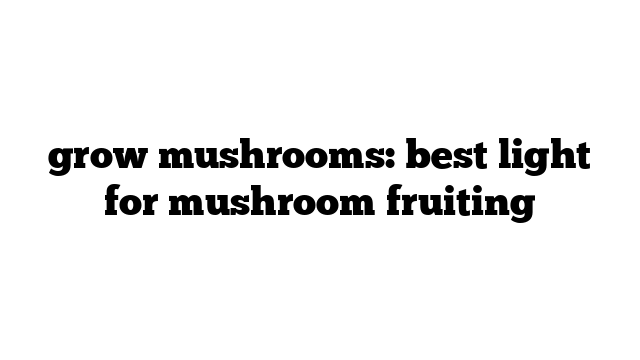When it comes to growing mushrooms, lighting is an important factor to consider during the fruiting stage. While mushrooms themselves do not perform photosynthesis, they still respond to light and can benefit from specific wavelengths and light cycles. In this article, we will delve into the different options for lighting mushrooms and explore what works best for their fruiting.
Understanding Mushroom Growth and Light
Before diving into the specifics of lighting for mushroom fruiting, it’s important to understand a few key concepts. Mushrooms are the fruiting bodies of fungi, and they require specific environmental conditions to grow and develop. These conditions include temperature, humidity, air circulation, and light.
For optimal growth, mushrooms require a balance of light and darkness. Light helps trigger the fruiting process and can influence the size, shape, and color of the mushrooms. On the other hand, darkness allows the mushrooms to develop and accumulate nutrients, which leads to better flavor and texture.
Different Types of Lights for Mushroom Fruiting
1. Natural Light
Mushrooms can be grown outdoors, where they can benefit from natural sunlight. However, direct sunlight can be too intense and can dry out the substrate or cause overheating. To avoid these issues, it’s best to provide indirect sunlight or dappled shade. This can be achieved by placing the mushrooms in a partially shaded area or creating a shade cloth structure.
2. Fluorescent Lights
Fluorescent lights are commonly used for indoor mushroom cultivation. They are energy-efficient, easy to install, and provide a wide spectrum of light. When using fluorescent lights, it’s recommended to choose cool white bulbs with a color temperature of around 6000-6500K. This temperature range provides a balanced spectrum of light that promotes fruiting and mushroom development.
3. LED Lights
LED lights have become increasingly popular for mushroom cultivation due to their energy efficiency and versatility. LED lights allow for precise control over the light spectrum and intensity. For mushroom fruiting, it’s best to use LED lights in the blue spectrum (around 450-490nm) or full-spectrum lights that provide a balanced range of wavelengths.
4. Incandescent Lights
Incandescent lights emit a warm, yellowish light and are not commonly used for mushroom fruiting. They tend to produce more heat and have a limited spectrum compared to fluorescent or LED lights. However, if you have no other options, you can use incandescent lights but be mindful of their heat output and limited spectrum.
Best Light Cycles for Mushroom Fruiting
In addition to choosing the right type of light, it’s essential to establish a proper light cycle for mushroom fruiting. Most mushrooms benefit from a 12/12 light cycle, which means 12 hours of light followed by 12 hours of darkness. This mimics natural day-night cycles and helps stimulate fruiting.
During the light period, it’s important to ensure even distribution of light to all mushrooms. Consider using reflective surfaces or arranging the lights to ensure each mushroom receives an equal amount of light for uniform growth.
Tips for Successful Mushroom Fruiting
– Avoid direct exposure to intense light, as it can lead to drying out of the substrate or overheating of the mushrooms.
– Maintain appropriate distance between the light source and mushrooms to prevent heat damage.
– Regularly monitor the temperature and humidity levels in the growing environment to create optimal conditions for fruiting.
– Rotate the mushrooms periodically to ensure even exposure to light and prevent any lopsided growth.
Conclusion
While mushrooms don’t perform photosynthesis, they still benefit from light during the fruiting stage. Choosing the right type of light and establishing a proper light cycle can significantly impact the quality and yield of your mushrooms. Fluorescent lights, LED lights, and indirect sunlight are all viable options for mushroom fruiting. Remember to create a balanced light cycle and monitor environmental conditions to ensure optimal growth and development. With the right light and care, you’ll be able to enjoy a bountiful harvest of delicious mushrooms.
